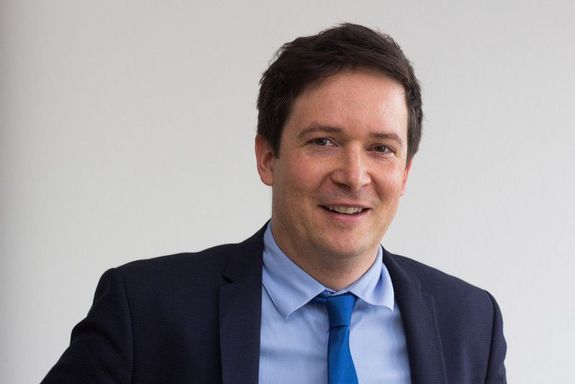What do raindrops on a rusty car roof and the cells of our own body have in common? Both cases involve interfaces between liquids and solid or smooth surfaces where interesting processes occur. These processes are hugely significant in many respects, although explaining them on the molecular scale is difficult. Countless different molecules interact with each other at these interfaces; their complex interaction determines the rate at which various chemical reactions occur or the strength of the adhesive force that bonds individual molecules to solid surfaces.
With his appointment to TU Wien on 1 October 2017, Professor Markus Valtiner is seeking to investigate these processes in more detail at the Institute of Applied Physics. To do this, he is developing innovative methods of measurement intended to track the dynamic behaviour of individual molecules on interfaces.
He was awarded an ERC Starting Grant, which he brought to TU Wien, for his ideas on the technical development of atomic force microscopes and surface force apparatus. On 1 November, the American Vacuum Society (AVS) also presented him with the prestigious "Peter Mark Memorial Award" for outstanding researcher in the category of researchers up to the age of 37.
An upgrade for the atomic force microscope
The atomic force microscope is a key instrument for the investigation of surfaces. A minute tip on a microscopically thin lever is moved over a surface, force is exerted between the tip and the atoms of the surface, and the lever is sometimes deflected more or less strongly. Making the minute movements of the lever visible with a laser beam enables the creation of a topographic map on an atomic scale.
"However, with an atomic force microscope, we don't have perfect control over all key parameters," says Markus Valtiner. "Setting the interval specifically to a set value is virtually impossible, and then there is always the problem of drift: on a microscopic scale, the probe doesn't stay exactly in the same place." Purely from the smallest unavoidable fluctuations in temperature, the probe can extend or contract, resulting in movements in the micrometre range during the measurement.
This difficulty can be overcome by a form of technology currently in use for what is known as surface force apparatus. "We use this apparatus to simultaneously determine the force and distance between two surfaces," explains Markus Valtiner. "We then use light beams to precisely measure the distance to an Ångstrom and keep everything stable." And it is this technology that Valtiner is now aiming to transfer onto the atomic force microscope - in fact, this is the key objective of his project, for which he has been awarded a 1.5 million euro ERC Starting Grant by the European Research Council.
Molecules that reach out to each other
This innovative equipment enables the behaviour of individual molecules to be studied: "For example, we want to consider the dynamic interaction of two biomolecules in real time. We will be able to follow it live, how they connect to and release each other," says Valtiner. One sits on the surface, the other on the tip of the atomic force microscope. If we can accurately measure the distance and if we manage to bring both molecules together in a controlled way, we can measure the force acting on the two molecules. Investigations like this at the level of individual molecules should then also make it possible to understand the behaviour of the entire interface - such as to predict any chemical reaction rates or account for the strength of adhesive connections.
There are many areas of application: "There are also extremely important biological effects that we want to investigate," says Valtiner. "You only have to think of a single biological cell: it contains liquid, but the cell and membrane structures are no more than a couple of nanometres apart. So a cell is, in a sense, nothing more than an interface between surfaces and liquid." But there are also important effects between liquid and solid states in the technical sphere - perhaps to help us understand corrosion better, or even to develop new fuel cells.
Vienna, Düsseldorf, Santa Barbara
Markus Valtiner grew up in Carinthia. In 1999, he began studying chemistry at TU Wien and soon developed a particular interest in the border area where physics and chemistry meet. For his dissertation, he undertook some research in a physics working group at the University of Lübeck. He moved to the Max-Planck-Institut für Eisenforschung in Düsseldorf to study for a PhD. After being awarded his doctorate, he continued his research as a post-doc, at the same time establishing contacts with the USA, and then in 2010, he took up a post-doc position at the University of California in Santa Barbara. In 2012, he returned to the Max-Planck-Institut in Düsseldorf, where he became a team leader. In 2016, he was finally appointed as a professor at TU Freiberg. However, it wasn't long before he followed the call of TU Wien, returning to his alma mater in 2017.
"TU Wien is the best place for me to work," believes Markus Valtiner. "Not only because I naturally feel comfortable in Vienna and also have family here, but also because my research interests are a perfect fit for TU Wien. At the Institute of Applied Physics, we have a first-class surface physics group, as well as outstanding research in the field of biophysics. In a sense, my working group is positioned between the two; we shall definitely be working closely with other groups here at the university."
Markus Valtiner's research work doesn't leave him much time for hobbies - but his family is important to him. His wife, from Vienna, has supported him throughout his career, moving to the USA, Germany and then back to Austria. "Our two children are five months and two years old - fortunately, at that age, moving around isn't a problem," believes Valtiner. "The older one has already got to grips with her new environment, she also feels very settled now in Vienna."
